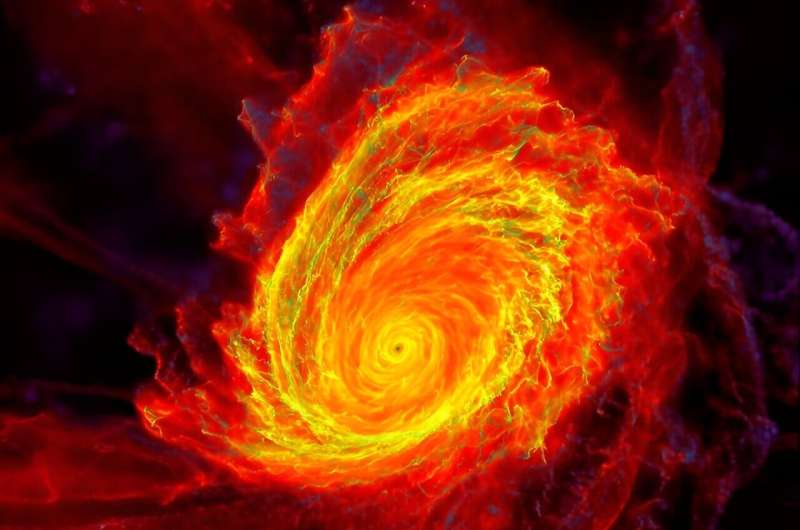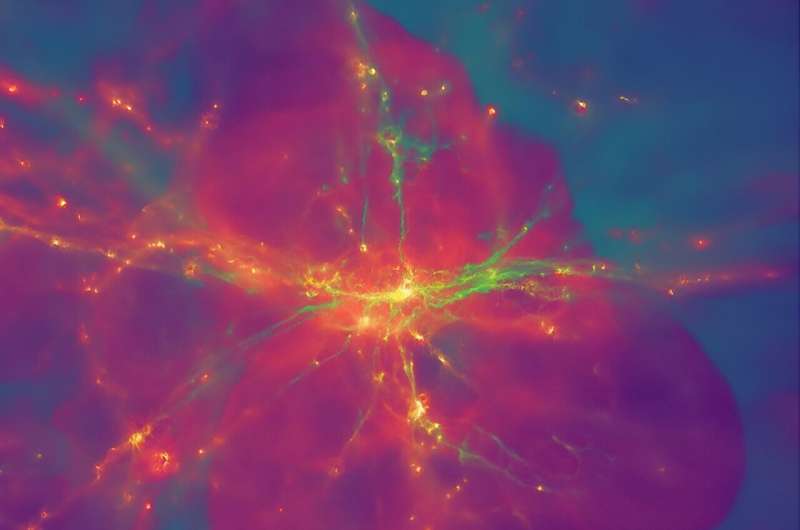
This simulation image shows a supermassive black hole, or quasar, surrounded by a swirling disk of material called an accretion disk. Credit: Caltech/Phil Hopkins group
A team of astrophysicists led by Caltech has succeeded for the first time in simulating the path of primordial gas from the early universe until it was swallowed up by a disk of matter feeding a single supermassive black hole. The new computer simulation upends the ideas astronomers have had about these disks since the 1970s and opens the door to new discoveries about the growth and evolution of black holes and galaxies.
“Our new simulation marks the culmination of several years of work from two major collaborations started here at Caltech,” says Phil Hopkins, the Ira S. Bowen Professor of Theoretical Astrophysics.
The first collaboration, called FIRE (Feedback in Realistic Environments), focused on the large scales of the universe, studying questions such as how galaxies form and what happens when galaxies collide. The other, called STARFORGE, was designed to look at much smaller scales, including how stars form in individual gas clouds.
“But there was a big gap between the two,” Hopkins says. “Now, for the first time, we’ve managed to bridge that gap.”
To achieve this, the researchers had to build a simulation with a resolution more than 1,000 times higher than the previous best in the field.
To the team’s surprise, as noted in Open Journal of AstrophysicsThe simulation revealed that magnetic fields play a much more important role than previously believed in forming and shaping the huge disks of matter that swirl and power supermassive black holes.
“Our theories told us that the disks should be flat like pancakes,” Hopkins says. “But we knew that wasn’t true, because astronomical observations reveal that the disks are actually fluffy, more like angel food cake. Our simulation helped us understand that magnetic fields support the disk material, making it fluffy.”
Visualizing activity around supermassive black holes using ‘super zooms’
In this new simulation, the researchers performed what they call a “super zoom” on a supermassive black hole, a monstrous object that lies at the heart of many galaxies, including our own Milky Way. These voracious and mysterious bodies contain thousands to billions of times the mass of the Sun and therefore have a huge effect on anything that comes near.
Astronomers have known for decades that gas and dust drawn in by the formidable gravity of these black holes isn’t immediately sucked in. Instead, the material first forms a rapidly swirling disk called an accretion disk. And as the material is about to fall in, it radiates an enormous amount of energy, glowing with a brilliance unmatched by anything else in the universe. But little is still known about these active supermassive black holes, called quasars, and how the disks that power them form and behave.
Although disks surrounding supermassive black holes have been imaged before (the Event Horizon Telescope imaged disks surrounding black holes at the heart of our own galaxy in 2022 and Messier 87 in 2019), these disks are much closer and more docile than those orbiting quasars.
To visualize what’s happening around these more active, more distant black holes, astrophysicists use supercomputer simulations. They feed thousands of computer processors running in parallel with information about the physics at work in these galactic environments, from the basic equations that govern gravity to how to treat dark matter and stars.
This data includes many algorithms, or sets of instructions, that computers must follow to recreate complex phenomena. For example, computers know that once gas becomes dense enough, a star forms. But the process is not that simple.
“If you just say that gravity pulls everything down and then the gas forms a star and the stars accumulate, you’re completely wrong,” Hopkins says.
After all, stars have many functions that affect their environment. They emit radiation that can heat or push the surrounding gas. They blow winds like the solar wind created by our own sun, which can carry matter away. They explode as supernovae, sometimes throwing matter out of galaxies or changing the chemistry of their environment. So computers also need to know all the ins and outs of this “stellar feedback,” because it regulates how many stars a galaxy can actually form.
Building a simulation that spans multiple scales
But at these larger scales, the most important physics to include and the approximations that can be made differ from those at smaller scales. For example, at galactic scales, the intricate details of how atoms and molecules behave are extremely important and must be incorporated into any simulation. However, scientists agree that when simulations focus on the more immediate area around a black hole, molecular chemistry can be largely ignored because the gas there is too hot for atoms and molecules to exist. Instead, what exists there is hot ionized plasma.
Creating a simulation that could cover all relevant scales down to the level of a single accretion disk around a supermassive black hole was a huge computational challenge, which also required code that could handle all the physics.
“Some codes had the physics needed to solve the small-scale part of the problem and some had the physics needed to solve the larger, cosmological part of the problem, but nothing that had both,” Hopkins says.

An earlier image from the simulation shows a tangle of merging galaxies. Credit: Caltech/Phil Hopkins group
The Caltech-led team used a code called GIZMO for both the large-scale and small-scale simulation projects. Importantly, they designed the FIRE project so that all the physics they added to it could work with the STARFORGE project, and vice versa.
“We built it in a very modular way, so you could turn on and off any piece of physics you wanted for a given problem, but they were all compatible with each other,” Hopkins says.
This allowed the scientists to simulate a black hole about 10 million times the mass of our Sun, at the dawn of the universe. The simulation then zooms in on this black hole as a giant stream of material rips out of a star-forming gas cloud and begins swirling around the supermassive black hole. The simulation can continue to zoom in, resolving a finer area at each step as it follows the gas on its way to the hole.
Surprisingly soft magnetic discs
“In our simulation, we see this accretion disk forming around the black hole,” Hopkins says. “We would have been very excited if we had just seen this accretion disk, but what’s very surprising is that the simulated disk doesn’t look like what we’ve been expecting for decades.”
In two seminal papers from the 1970s describing the accretion disks that power supermassive black holes, scientists assumed that thermal pressure (the change in pressure caused by the changing temperature of the gas in the disks) played the primary role in keeping the disks from collapsing under the enormous gravity they experience near the black hole. They acknowledged that magnetic fields might play a minor role in strengthening the disks.
In contrast, the new simulation revealed that the pressure exerted by the magnetic fields of these disks was actually 10,000 times greater than the pressure exerted by the heat of the gas.
“So the disks are almost entirely controlled by magnetic fields,” Hopkins says. “Magnetic fields serve many functions, one of which is to support the disks and make the material swell.”
This realization changes a host of predictions scientists can make about these accretion disks, such as their mass, density and thickness, how quickly matter should be able to move from them toward a black hole, and even their geometry (for example, whether the disks might be out of balance).
Hopkins hopes that this new ability to bridge the gap between cosmological simulation scales will open up many new avenues of research. For example, what happens in detail when two galaxies merge? What types of stars form in the dense regions of galaxies where conditions are different from those around our Sun? What might the first generation of stars in the universe have looked like?
“There’s so much to do,” he said.
More information:
Philip F. Hopkins et al, FORGE’d in FIRE: Resolving the Termination of Star Formation and the Structure of AGN Accretion Disks from Cosmological Initial Conditions, Open Journal of Astrophysics (2024). DOI: 10.21105/astro.2309.13115
Provided by California Institute of Technology
Quote: Cosmic simulation reveals how black holes grow and evolve (2024, July 2) retrieved July 3, 2024 from https://phys.org/news/2024-07-cosmic-simulation-reveals-black-holes.html
This document is subject to copyright. Apart from any fair dealing for the purpose of private study or research, no part may be reproduced without written permission. The content is provided for informational purposes only.